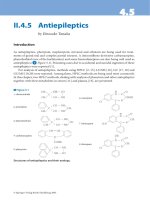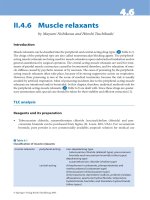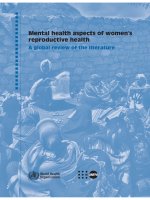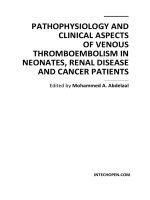Medical and Psychosocial Aspects of Chronic Illness and Disability pptx
Bạn đang xem bản rút gọn của tài liệu. Xem và tải ngay bản đầy đủ của tài liệu tại đây (3.5 MB, 598 trang )
Medical and
Psychosocial Aspects of
Chronic Illness and
Disability,
Third Edition
Donna Falvo, RN, PhD, CRC
JONES AND BARTLETT PUBLISHERS
TeAm YYePG
Digitally signed by TeAm YYePG
DN: cn=TeAm YYePG, c=US, o=TeAm YYePG,
ou=TeAm YYePG, email=
Reason: I attest to the accuracy and integrity of
this document
Date: 2005.05.12 22:09:15 +08'00'
Third Edition
Donna Falvo, RN, PhD, CRC
Adjunct Professor
Rehabilitation Psychology and Counseling
Allied Health Sciences, School of Medicine
The University of North Carolina
at Chapel Hill
Medical and
Psychosocial Aspects
of Chronic Illness
and Disability
Copyright © 2005 by Jones and Bartlett Publishers, Inc.
All rights reserved. No part of the material protected by this copyright may be reproduced or
utilized in any form, electronic or mechanical, including photocopying, recording, or by any
information storage and retrieval system, without written permission from the copyright owner.
Library of Congress Cataloging-in-Publication Data
Falvo, Donna R.
Medical and psychosocial aspects of chronic illness and disability / Donna Falvo.—3rd ed. p. ; cm.
Includes bibliographical references and index.
ISBN 0-7637-3166-8 (casebound)
1. Chronic diseases. 2. Chronically ill—Rehabilitation. 3. Chronic diseases—Social aspects.
4. Chronic diseases—Psychological aspects.
[DNLM: 1. Chronic Disease. 2. Disabled Persons—psychology.
3. Disabled Persons—rehabilitation. 4. Social Adjustment. WT 500 F197m 2005] I. Title.
RC108.F35 2005
616'.044–dc22
2004017494
Production Credits
Acquisitions Editor: Kevin Sullivan
Production Director: Amy Rose
Associate Production Editor: Tracey Chapman
Associate Editor: Amy Sibley
Associate Marketing Manager: Emily Ekle
Cover Design: Anne Spencer
Manufacturing Buyer: Amy Bacus
Composition: Bill Noss Graphic Design
Printing and Binding: Malloy, Inc.
Cover Printing: Malloy, Inc.
Printed in the United States of America
09 08 07 06 05 10 9 8 7 6 5 4 3 2 1
World Headquarters
Jones and Bartlett Publishers
40 Tall Pine Drive
Sudbury, MA 01776
978-443-5000
www.jbpub.com
Jones and Bartlett Publishers
Canada
2406 Nikanna Road
Mississauga, ON L5C 2W6
CANADA
Jones and Bartlett Publishers
International
Barb House, Barb Mews
London W6 7PA
UK
Dedication
This book is dedicated to the memory of
Dr. Alan Woolf,
A man of science, presence, integrity, strength, and honor
This page intentionally left blank
About the Author
Donna Falvo, R.N., Ph.D., CRC is Adjunct Professor at the University of North Carolina
at Chapel Hill School of Medicine, Division of Rehabilitation Psychology and
Counseling. She is a Registered Nurse, Licensed Psychologist, and Certifed Rehabilitation
Counselor. She has over 30 years serving as teacher, clinician, and researcher. A former
Professor and Coordinator of Rehabilitation Counseling, Rehabilitation Institute,
Southern Illinois University, she was named a Mary Switzer Scholar in 1986, and elect-
ed to Sigma XI National Scientific Research Society in 1995. She was elected President
of the American Rehabilitation Counseling Association in 1998 and currently serves
on the Editorial Board of the Rehabilitation Counseling Bulletin. She is the author of over
40 articles and book chapters and, in addition to authoring the two previous editions
of Medical and Psychosocial Aspects of Chronic Illness and Disability, she is author of the
book Effective Patient Education: A Guide to Increased Compliance, also in its third edition.
v
This page intentionally left blank
Eileen Burker, PhD, CRC
Associate Professor
Department of Allied Health
Science
Divison of Rehabilitation
Psychology and
Counseling
School of Medicine
The University of North
Carolina at Chapel Hill
Catherine T. Calvert, PhD,
CRC
Rehabilitation Counselor
North Carolina Jaycee Burn
Center
University of North
Carolina Hospitals
Chapel Hill, North Carolina
Patrick P. Carone, MD
Psychiatrist
Carolina Rehabilitation and
Surgical Associates
Cary, North Carolina
Stacy Carone, EdD, CRC
Assistant Professor
Department of Allied Health
Science
Division of Rehabilitation
Psychology and
Counseling
School of Medicine
The University of North
Carolina at Chapel Hill
Richard E. Falvo, PhD
Adjunct Professor
Cell & Molecular Physiology
School of Medicine
The University of North
Carolina at Chapel Hill
Ernest Grant, RN, MSN
Outreach Coordinator
North Carolina Jaycee Burn
Center
University of North
Carolina Hospitals
Chapel Hill, North Carolina
Dawn E. Kleinman, MD
Dermatologist
Alamance Skin Center
Burlington, North Carolina
Fred Price, RN, MBA (c)
Nurse Manager
North Carolina Jaycee Burn
Center
University of North
Carolina Hospitals
Chapel Hill, North Carolina
Dianne Rawdanowicz
Rehabilitation Counselor
N.C. Division Vocational
Rehabilitation Services
Department of Health and
Human Services
Raleigh, North Carolina
Stephanie J. Sjoblad, AuD
Clinic Director
Audiologist/ Assistant
Professor
Allied Health Sciences
Division of Speech/Hearing
School of Medicine
The University of North
Carolina at Chapel Hill
vii
Special thanks to the following people who generously volunteered their time to read,
review, critique, and discuss various sections of the book. Their dedication and com-
mitment to individuals with chronic illness and disability is greatly appreciated by the
author as well as by the individuals they serve.
Acknowledgments
C HAPTER 1
This page intentionally left blank
In its third edition, Medical and Psycho-
social Aspects of Chronic Illness and Disa-
bility has been revised and updated.
Certain sections, such as those on condi-
tions of the nervous system have been
substantially expanded. Added to the
end of each chapter are brief case studies
to stimulate discussion. Cases are hypo-
thetical and not based on any specific case
or individual.
This book is designed for nonmedical
professionals and students who have lit-
tle prior medical knowledge but who work
with individuals with chronic illness and
disability and need to have an understand-
ing of medical conditions, their implica-
tions, and need to have an understanding
of medical terms. It is designed as a refer-
ence book for professionals in the field as
well as a textbook for students. The book
continues to use a functional approach to
understanding a number of medical con-
ditions. In an attempt to reinforce this
approach, an Appendix on Functional
Limitations has been added (Appendix E).
Chronic illness and disability impact all
areas of individual’s and their family’s
lives. Only by understanding an individ-
ual’s total experience with chronic illness
and disability and how all areas of their
life are affected are professionals fully able
to help them reach their goals. The focus
of the book is to help professionals and
students understand medical and psycho-
social aspects of chronic illness and dis-
ability and how they affect an individual’s
functioning in all areas of life, including
psychological and social impact, impact
on activities of daily living, and on voca-
tional function. — DRF
ix
Preface
C HAPTER 1
This page intentionally left blank
CHAPTER 1 PSYCHOSOCIAL AND FUNCTIONAL ASPECTS OF CHRONIC
ILLNESS AND DISABILITY 1
Impact of Chronic Illness and Disability 1
Disease and Illness 2
Impairment, Disability, and Handicap 2
Stress in Chronic Illness and Disability 3
Coping Style and Strategies 4
Denial 5
Regression 5
Compensation 5
Rationalization 6
Diversion of Feelings 6
Emotional Reactions to Chronic Illness or Disability 6
Grief 6
Fear and Anxiety 7
Anger 7
Depression 7
Guilt 7
Chronic Illness and Disability Through the Life Cycle 8
Chronic Illness or Disability in Childhood 9
Chronic Illness or Disability in Adolescence 10
Chronic Illness or Disability in Young Adulthood 10
Chronic Illness or Disability in Middle Age 11
Chronic Illness or Disability in Older Adulthood 11
Other Issues in Chronic Illness and Disability 12
Self-Concept and Self-Esteem 12
Body Image 12
Stigma 13
The Impact of Uncertainty 13
Invisible Disabilities 14
Sexuality 14
Family Adaptation to Chronic Illness and Disability 15
Quality of Life 16
Adherence to Prescribed Treatment and Recommendations 17
Patient (Client and Family) Education 19
Stages of Adaptation and Adjustment 19
Functional Aspects of Chronic Illness and Disability 20
Psychological Issues in Chronic Illness and Disability 20
xi
Table of Contents
C HAPTER 1
Lifestyle Issues in Chronic Illness and Disability 20
Social Issues in Chronic Illness and Disability 21
Vocational Issues in Chronic Illness and Disability 21
CHAPTER 2 CONDITIONS OF THE NERVOUS SYSTEM: PART I
CONDITIONS OF THE BRAIN 25
Normal Structure and Function of the Nervous System 25
Nerve Cells 26
The Central Nervous System 26
The Brain 28
Conditions Affecting the Brain 30
Traumatic and Atraumatic Brain Damage 30
Right-Sided Versus Left-Sided Brain Damage 37
Functional Consequences of Brain Damage 38
Treatment and Management of Brain Damage 46
Functional Implications of Brain Damage 49
Cerebral Palsy 55
Epilepsy 60
Diagnostic Procedures Used for Conditions of the Nervous System 67
Skull Roentgenography (X-ray) 67
Computed Tomography (CT Scan, CAT Scan) 67
Magnetic Resonance Imaging (MRI) 68
Brain Scan (Brain Nuclear Scan) 68
Positron Emission Transaxial Tomography (PET Scan) 69
Cerebral Angiography 69
Lumbar Puncture (Cerebrospinal Fluid Analysis, Spinal Tap) .69
Electroencephalography (EEG) 69
Neuropsychological Tests 70
Psychosocial Issues in Nervous System Conditions
Involving the Brain 70
Case Studies 70
CHAPTER 3 CONDITIONS OF THE NERVOUS SYSTEM: PART II
CONDITIONS OF THE SPINAL CORD AND PERIPHERAL
NERVOUS SYSTEM AND NEUROMUSCULAR CONDITIONS 73
Normal Structure and Function of the Spinal Cord and
Peripheral Nervous System 73
The Spinal Cord 73
The Peripheral Nervous System 74
Conditions Affecting the Spinal Cord 76
Spinal Cord Injuries 76
Spina Bifida 87
Poliomyelitis and Post-Polio Syndrome 90
Neuromuscular Conditions 94
Parkinson’s Disease 94
Huntington’s Disease (Huntington’s Chorea) 98
XII
MEDICAL AND PSYCHOSOCIAL ASPECTS OF CHRONIC ILLNESS AND DISABILITY
Amyotrophic Lateral Sclerosis (ALS; Lou Gehrig’s Disease) 100
Guillain-Barré Syndrome 102
Myasthenia Gravis 104
Muscular Dystrophy 104
Other Conditions of the Nervous System 104
Multiple Sclerosis 104
Central Sleep Apnea 110
Narcolepsy 110
Lyme Disease 111
Bell’s Palsy 111
Diagnostic Procedures in Conditions of the Spinal Cord or
Neuromuscular or Peripheral Nervous System 111
Spine Roentgenography (X-ray) 111
Electromyography (EMG) and Nerve Conduction
Velocity Studies 111
General Issues in Nervous System Conditions 112
Psychosocial Issues in Conditions of the Nervous System 112
Vocational Issues in Conditions of the Nervous System 117
Case Studies 118
CHAPTER 4 CONDITIONS OF THE EYE AND BLINDNESS 123
Normal Structure and Function of the Eye 123
Measuring Vision 125
Types of Visual Impairments 126
Conditions Causing Visual Impairment or Blindness 126
Refractive Errors 126
Difficulty with Coordination of the Eyes 127
Opacities of the Eye 127
Injuries to the Eyes 128
Inflammation and Infections of the Eye 129
Glaucoma 129
Retinopathy 131
Retinal Detachment 132
Retinitis Pigmentosa 132
Macular Degeneration 132
Diagnostic Procedures for Conditions of the Eye 133
Comprehensive Eye Exam 133
Tonometry 133
Gonioscopy 133
Ophthalmoscopic Examination 133
Fluorescein Angiography 134
Treatment and Management of Conditions of the Eye
and Blindness 134
Eyeglasses and Contact Lenses 134
Refractive Eye Surgery 134
Prosthetic Devices and Eye Replacement 135
Table of Contents xiii
Assistive Devices and Low-Vision Aids 135
Orientation and Mobility Training 136
Psychosocial Issues in Conditions of the Eye and Blindness 137
Special Issues for Individuals Who Are Partially Sighted 137
Psychological Issues in Conditions of the Eye
and Blindness 138
Lifestyle Issues in Conditions of the Eye and Blindness 139
Social Issues for Individuals with Visual Conditions
or Blindness 140
Vocational Issues for Individuals with Conditions of the Eye
or Blindness 140
Case Studies 141
CHAPTER 5 HEARING LOSS AND DEAFNESS 143
Normal Structure and Function of the Ear 143
The Outer Ear 143
The Middle Ear 143
The Inner Ear 144
Hearing Loss and Deafness 145
Frequency and Intensity of Sound 145
Definition and Classification of Hearing Loss 145
Causes of Hearing Loss 148
Conditions of the Ear Contributing to Hearing Loss 148
Conditions of the Vestibular System 151
Diagnostic Procedures 151
Identification of Hearing Loss 151
Evaluation of the Vestibular System (Disorders of Balance) 156
Treatment of Hearing Loss and Deafness 156
Surgical Procedures 156
Devices and Aids for Hearing Loss 157
Psychosocial Issues in Hearing Loss 164
Deafness and Deaf Culture 164
Psychological Issues in Hearing Loss 166
Lifestyle Issues in Hearing Loss 167
Social Issues in Hearing Loss 167
Vocational Issues in Hearing Loss 169
Case Studies 170
CHAPTER 6 PSYCHIATRIC DISABILITIES 173
Defining Psychiatric Disability 173
The Diagnostic and Statistical Manual of Mental Disorders 173
Common Psychiatric Disabilities 175
Conditions Diagnosed in Infancy, Childhood,
or Adolescence 175
Delirium and Dementia 179
Schizophrenia 182
XIV
MEDICAL AND PSYCHOSOCIAL ASPECTS OF CHRONIC ILLNESS AND DISABILITY
Mood Disorders 185
Anxiety Disorders 186
Somatoform Disorders 188
Factitious Disorders 189
Dissociative Disorders 189
Personality Disorders 189
Diagnostic Procedures in Psychiatric Disability 190
Uses of Diagnostic Psychological Testing 190
Intelligence Tests 190
Mental Status Examination and Assessment
Through Interviews 190
Personality Assessment 191
Neuropsychological Testing 191
Behavioral Assessment 192
General Treatment of Psychiatric Disability 192
Psychiatric Rehabilitation 192
Nonpharmacologic Approaches to Treatment of
Psychiatric Disability 193
Pharmacologic Approaches to Treatment of
Psychiatric Disability 194
Electroconvulsive Therapy 197
Psychosocial and Vocational Issues in Psychiatric Disability 197
Psychological Issues 197
Lifestyle Issues 198
Social Issues 198
Vocational Issues 199
Case Studies 200
CHAPTER 7 CONDITIONS RELATED TO SUBSTANCE USE 205
Defining Substance Use Disorders 205
Substance Abuse and Dependence 205
Intoxication 206
Withdrawal 206
Addiction 207
Substance Use and Chronic Illness and Disability 207
Physical Effects of Alcohol Abuse and Dependence 208
Treatment of Alcohol Dependence 209
Alcohol-Related Medical Illness 209
Use Disorders Involving Other Substances 213
Caffeine and Nicotine 213
Sedatives 214
Opioids 215
Stimulants 215
Cannabis 217
Hallucinogens 218
Inhalants 218
Table of Contents xv
Medical Consequences of Abuse of Other Drugs and Substances 219
Drug-Related Illness 219
Diagnostic Procedures 221
Screening Instruments 222
Direct Drug Screening 222
Medical Evaluation 222
Behavioral and Psychological Screening 223
Treatment of Substance Use Disorders 223
Psychosocial and Vocational Issues in Substance Abuse 224
Psychological Issues 224
Lifestyle Issues 224
Social Issues 225
Vocational Issues 226
Case Studies 227
CHAPTER 8 CONDITIONS OF THE BLOOD AND IMMUNE SYSTEM 231
Normal Structure and Function 231
Normal Structure and Function of Red Blood Cells 231
Normal Structure and Function of White Blood Cells and
Immunity 232
Normal Structure and Function of Platelets
and Coagulation 234
Conditions Affecting the Blood or Immune System 234
Anemia 234
Thalassemia 236
Polycythemia 236
Agranulocytosis (Neutropenia) 236
Pupura 237
Leukemia 237
Hemophilia 237
Sickle Cell Disease 240
Human Immunodeficiency Virus (HIV) Infection 244
Diagnostic Procedures for Conditions Affecting the Blood
or Immune System 250
Standard Blood Tests 250
Bleeding Time Test 250
Prothrombin Time (PT, Pro Time) Test 251
Partial Thromboplastin Time (PTT) Test 251
Bone Marrow Aspiration 251
ELISA and Western Blot 251
Hemoglobin Electrophoresis 251
Sickle Cell Prep 251
General Treatment for Conditions Affecting the Blood
or Immune System 252
Transfusion 252
Bone Marrow Transplant 252
XVI
MEDICAL AND PSYCHOSOCIAL ASPECTS OF CHRONIC ILLNESS AND DISABILITY
Psychosocial Issues in Conditions Affecting the Blood
or Immune System 252
Psychological Issues 252
Lifestyle Issues 253
Social Issues 254
Vocational Issues in Conditions Affecting the Blood
or Immune System 254
Case Studies 255
CHAPTER 9 ENDOCRINE CONDITIONS 259
Normal Structure and Function of the Endocrine System 259
Conditions of the Endocrine System 261
Hyperthyroidism (Graves’ Disease, Throtoxicosis) 261
Hypothyroidism (Myxedema) 262
Cushing’s Syndrome (Adrenal Cortex Hyperfunction) 262
Addison’s Disease (Adrenocortical Insufficiency) 263
Diabetes Insipidus 263
Diabetes Mellitus 263
Diagnostic Procedures for Conditions of the Endocrine System 272
Blood Tests for Thyroid Function 272
Blood Tests for Diabetes Mellitus 272
General Treatment of Endocrine Conditions 272
Psychosocial and Vocational Issues in Endocrine Conditions 273
Psychological Issues 273
Lifestyle Issues 273
Social Issues 273
Vocational Issues in Endocrine Conditions 273
Case Studies 274
CHAPTER 10 CONDITIONS OF THE GASTROINTESTINAL SYSTEM 277
Normal Structure and Function of the Gastrointestinal System 277
Conditions of the Gastrointestinal System 279
Conditions of the Mouth 279
Conditions of the Esophagus 280
Conditions of the Stomach 282
Conditions of the Intestine 285
Conditions of the Accessory Organs of the
Gastrointestinal System 291
General Diagnostic Procedures for Conditions of
the Gastrointestinal System 294
Barium Swallow (Upper Gastrointestinal Series) 294
Barium Enema (Lower Gastrointestinal Series) 294
Esophageal Manoscopy (Manometry) 294
Endoscopy (Gastroscopy) 295
Proctoscopy, Colonoscopy, and Sigmoidoscopy 295
Cholecystography 295
Table of Contents xvii
Cholangiography 295
Ultrasonography (Abdominal Sonography) 295
Computer Tomography (CT Scan, CAT Scan) 295
Radionuclide Imaging 296
Biopsy 296
Abdominal Paracentesis 296
Laparoscopy 296
General Treatment for Conditions of the Gastrointestinal System 296
Medications 296
Hyperalimentation (Total Parenteral Nutrition) 297
Stress Management 297
Psychosocial Issues in Conditions of the Gastrointestinal System 297
Psychological Issues 297
Lifestyle Issues 298
Social Issues 299
Vocational Issues in Conditions of the Gastrointestinal System 299
Case Studies 300
CHAPTER 11 CARDIOVASCULAR CONDITIONS 303
Normal Structure and Function of the Cardiovascular System 303
Cardiovascular Conditions 305
Arteriosclerosis (Atherosclerosis) 305
Aneurysm 306
Endocarditis 306
Pericarditis 307
Rheumatic Heart Disease 307
Hypertension 307
Coronary Artery Disease: Angina Pectoris
and Myocardial Infarction 309
Cardiac Arrhythmia 312
Valvular Heart Conditions 315
Congestive Heart Failure 316
Peripheral Vascular Conditions 317
Diagnostic Procedures in Cardiovascular Conditions 320
Chest Roentgenography (X-ray) 320
Electrocardiography 320
Holter Monitor 320
Cardiac Stress Test 320
Angiography 321
Echocardiography 321
Radionuclide Imaging 321
Cardiac Catheterization 321
General Treatment of Cardiovascular Conditions 322
Medical Treatment 322
Surgical Treatment 322
XVIII
MEDICAL AND PSYCHOSOCIAL ASPECTS OF CHRONIC ILLNESS AND DISABILITY
Cardiac Rehabilitation 325
Psychosocial Issues in Cardiovascular Conditions 326
Psychological Issues 326
Lifestyle Issues 327
Social Issues 327
Vocational Issues in Cardiovascular Conditions 328
Case Studies 328
CHAPTER 12 CONDITIONS OF THE RESPIRATORY (PULMONARY) SYSTEM 331
Normal Structure and Function of the Respiratory System 331
Conditions of the Respiratory System 333
Infections of the Respiratory System 333
Chronic Lung Diseases 337
Occupational Lung Diseases (Pneumoconiosis; Asbestosis;
Silicosis; Berylliosis; Byssinosis; Occupational Asthma) 346
Other Conditions Affecting Respiratory Function 348
Restrictive Pulmonary Disease 348
Bronchiectasis 348
Cystic Fibrosis 348
Apnea 351
Chest Injuries 352
Diagnostic Procedures for Respiratory Conditions 353
Chest Roentgenography (X-ray) 353
Bronchoscopy 353
Laryngoscopy 353
Pulmonary Angiography 353
Pulmonary Function Tests 353
Ventilation/Perfusion Scan (Lung Scan) 354
General Treatment for Respiratory Conditions 354
Psychosocial Issues in Respiratory Conditions 355
Psychological Issues 355
Lifestyle Issues 356
Social Issues 357
Vocational Issues in Respiratory Conditions 358
Case Studies 359
CHAPTER 13 URINARY TRACT AND RENAL CONDITIONS 363
Normal Structure and Function of the Urinary Tract 363
Urinary Tract and Renal Conditions 365
Cystitis (Lower Urinary Tract Infection) 365
Pyelonephritis 365
Urinary or Renal Calculi (Kidney Stones;
Nephrolithiasis; Urolithiasis) 366
Hydronephrosis 367
Glomerulonephritis 367
Table of Contents xix
Nephrosis (Nephrotic Syndrome) 368
Polycystic Kidney Disease 368
Nephrectomy 368
Renal Failure 369
Diagnostic Procedures for Renal and Urinary Tract Conditions 383
Urinalysis 383
Urine Culture 383
Blood Urea Nitrogen 383
Serum Creatinine 383
Creatinine Clearance Test 383
Kidney, Ureter, and Bladder Roentgenography (KUB) 384
Intravenous Pyelogram 384
Cystoscopy 384
Retrograde Pyelography 384
Renal Biopsy 384
Renal Angiography 385
Psychosocial Issues in Renal and Urinary Tract Conditions 385
Psychological Issues 385
Lifestyle Issues 385
Social Issues 386
Vocational Issues in Renal and Urinary Tract Conditions 386
Case Studies 387
CHAPTER 14 CONDITIONS OF THE MUSCULOSKELETAL SYSTEM 389
Normal Structure and Function of the Musculoskeletal System 389
The Skeletal System 389
The Muscular System 392
Conditions of the Musculoskeletal System 392
Trauma 392
Overuse and Repetitive Motion Injuries 395
Degenerative Conditions 396
Back Pain 398
Chronic Pain 402
Amputation 406
Rheumatoid and Autoimmune Conditions 411
Other Conditions of the Musculoskeletal System 420
Diagnostic Procedures for Conditions of the
Musculoskeletal System 422
Roentgenography (Radiography, X-rays) 422
Arthrography 422
Diskography and Myelography 422
Arthroscopy 422
Arthrocentesis 422
Bone Scan 423
Magnetic Resonance Imaging (MRI) 423
XX
MEDICAL AND PSYCHOSOCIAL ASPECTS OF CHRONIC ILLNESS AND DISABILITY
Computer Tomography (Computed Axial Tomography,
CAT Scan, CT Scan) 423
Blood Tests 424
General Treatments for Conditions of the Musculoskeletal System 424
Medications 424
Hyperbaric Oxygen Therapy 425
Physical Therapy 425
Casts 426
Assistive Devices 426
Orthoses 426
Traction 427
Surgical Treatment 427
Psychosocial Issues in Conditions of the Musculoskeletal System 428
Psychological Issues 428
Lifestyle Issues 429
Social Issues 430
Vocational Issues in Conditions of the Musculoskeletal System 431
Case Studies 432
CHAPTER 15 SKIN CONDITIONS AND BURNS 437
Normal Structure and Function of the Skin 437
Psychological, Social, and Vocational Impact of Skin Conditions 438
Skin Conditions 439
Dermatitis 439
Allergic Reactions 439
Psoriasis 440
Infections of the Skin 442
Acne 442
Herpes Zoster (Shingles) 442
Skin Cancers 443
General Diagnostic Procedures for Conditions of the Skin 443
Biopsy 443
Scrapings, Cultures, and Smears 443
Patch Tests 443
General Treatment of Conditions of the Skin 443
Medications 443
Dressings and Therapeutic Baths or Soaks 444
Light Treatment (Phototherapy) 444
Dermabrasion 444
Chemical Face Peeling 444
Plastic and Reconstructive Surgery 444
Burns 445
Types of Burn Injury 445
Burn Depth 446
Burn Severity 447
Table of Contents xxi
Burn Treatment 448
Psychosocial Issues in Burn Injury 451
Vocational Issues in Burn Injury 454
Psychosocial and Vocational Issues in Conditions of the Skin 455
Psychological Issues 455
Lifestyle Issues 455
Social Issues 455
Vocational Issues 456
Case Studies 456
CHAPTER 16 CANCERS 459
Normal Structure and Function of the Cell 459
Development of Cancer 459
Causes of Cancer 460
Types of Cancer 461
Staging and Grading of Cancer 461
General Diagnostic Procedures in Cancer 462
Radiographic Procedures (X-ray) 462
Diagnostic Surgery 462
Cytology 462
Endoscopy 463
Nuclear Medicine 463
Laboratory Tests 463
General Treatment of Cancer 463
Surgical Procedures 464
Chemotherapy 464
Radiation Therapy 465
Biological Therapies 466
Common Cancers and Specific Treatments 467
Cancer of the Gastrointestinal Tract 467
Cancer of the Larynx 468
Cancer of the Lung 471
Cancer of the Musculoskeletal System 471
Cancer of the Urinary System 471
Cancer of the Brain or Spinal Cord 473
Lymphomas 473
Multiple Myeloma 474
Leukemia 474
Cancer of the Breast 475
Gynecological Cancer 477
Cancer of the Prostate 477
Skin Cancers 478
Psychosocial Issues in Cancer 478
Psychological Issues 478
Lifestyle Issues 480
Social Issues 480
XXII
MEDICAL AND PSYCHOSOCIAL ASPECTS OF CHRONIC ILLNESS AND DISABILITY
Vocational Issues in Cancer 481
Case Studies 482
CHAPTER 17 ASSISTIVE DEVICES 485
Defining Assistive Technology 485
Individual Assessment 486
Types of Assistive Devices 487
Devices for Activities of Daily Living 487
Mobility Aids 488
Sensory Devices 488
Communication Devices 488
Cognitive Memory Aids 489
Adaptive Computer Aids 489
Controls and Switches 489
Environmental Modifications 489
Other Types of Assistive Devices 489
Service Animals 490
Assistive Devices for Recreation 490
Assistive Devices in the Workplace 490
Appraisal of Assistive Devices and Alternatives 491
CHAPTER 18 MANAGED CARE AND CHRONIC ILLNESS AND DISABILITY 493
The Concept of Managed Care 493
Defining Managed Care 493
Organizational Models of Managed Care 494
Additional Concepts in Managed Care 494
Clinical Practice Guidelines 495
Ethical Issues in Managed Care 495
Impact of Managed Care on Individuals with Chronic Illness
or Disability 496
Future Issues Facing Managed Care 497
APPENDIX A MEDICAL TERMINOLOGY 499
APPENDIX B GLOSSARY OF MEDICAL TERMS 503
APPENDIX C MEDICATIONS 525
APPENDIX D GLOSSARY OF DIAGNOSTIC PROCEDURES 529
APPENDIX E FUNCTIONAL LIMITATIONS 535
INDEX 537
Table of Contents xxiii









